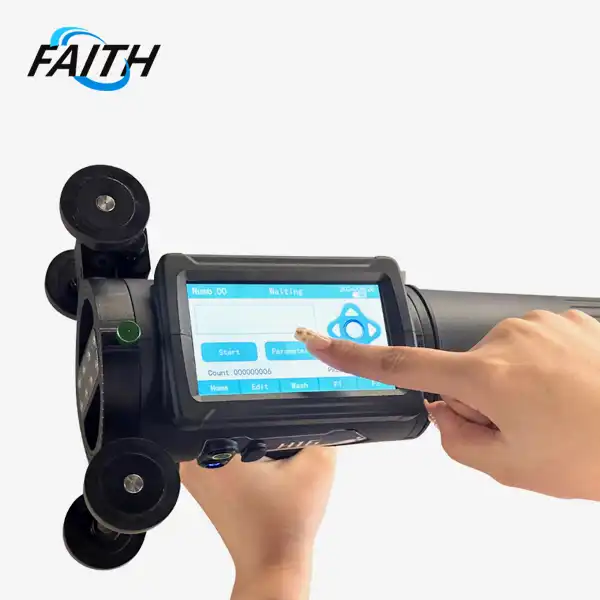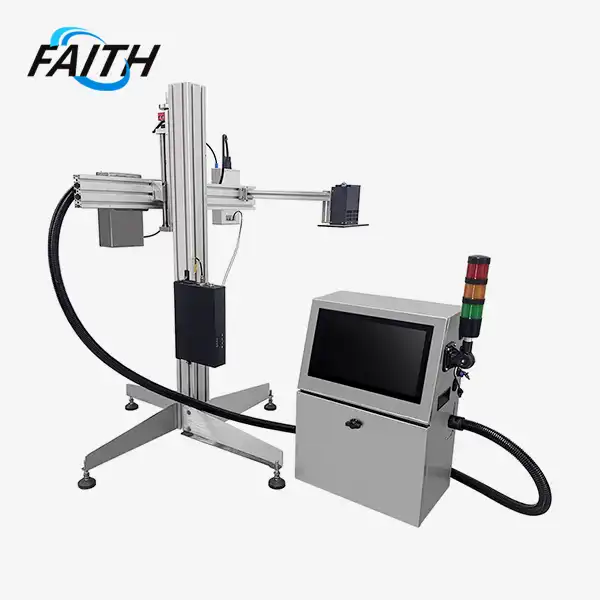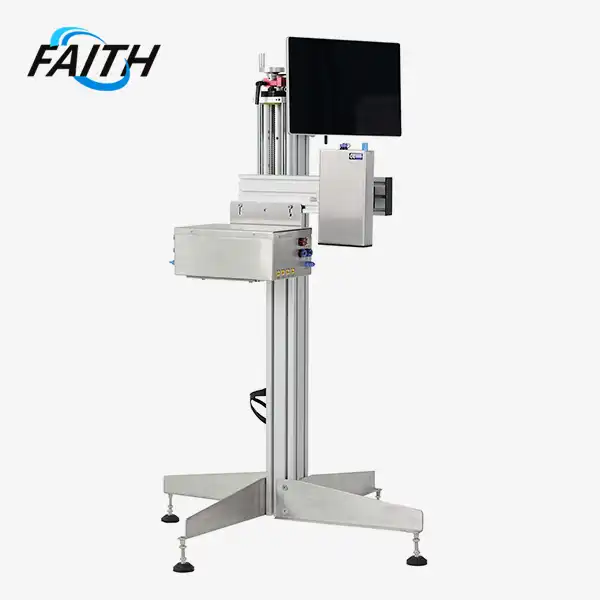Handheld Inkjet Label Printer: Essential Features and Applications
Handheld inkjet label printers have revolutionized on-demand labeling across various industries. These portable devices combine convenience with high-quality printing, making them indispensable tools for businesses of all sizes. From essential features like touchscreen interfaces and long-lasting batteries to diverse applications in logistics, manufacturing, and retail, handheld inkjet label printers offer unparalleled flexibility and efficiency. This article explores the key attributes and practical uses of these innovative printing solutions, highlighting how they can streamline operations and enhance productivity in today's fast-paced business environment.
Understanding the Core Features of Handheld Inkjet Label Printers
Portability and Ergonomic Design
One of the most significant advantages of handheld inkjet label printers is their portability. Manufacturers like Faith Technology have pushed the boundaries of compact design, creating devices that weigh as little as 240 grams. This lightweight construction allows users to carry and operate the printer with ease, reducing fatigue during extended use. The ergonomic design of these printers ensures comfortable handling, making them ideal for environments where mobility is crucial.
Moreover, the compact nature of these devices doesn't compromise their functionality. Many models, including those from Faith, incorporate advanced features within their small form factor. For instance, the inclusion of a 3.5-inch touchscreen display on some models allows for direct editing and operation without the need for additional devices or applications. This on-device functionality enhances usability in various work environments, from bustling warehouses to outdoor construction sites.
High-Resolution Printing Capabilities
Despite their small size, handheld inkjet label printers are capable of producing high-quality prints. Many models offer resolutions up to 600 DPI (dots per inch), ensuring crisp and clear text, barcodes, and even complex graphics. This high resolution is particularly important for printing small fonts, intricate logos, and machine-readable codes that require precision and clarity.
The print quality is further enhanced by advanced ink technologies. Faith printers, for example, utilize specially formulated inks that dry quickly and adhere well to a variety of surfaces. This ensures that labels remain legible and durable, even in challenging environments where they may be exposed to moisture, sunlight, or abrasion.
Versatile Connectivity Options
Modern handheld inkjet label printers offer a range of connectivity options to suit different operational needs. Wi-Fi capabilities allow for wireless printing from mobile devices or computers, enabling seamless integration with existing workflows. Some models also feature Bluetooth connectivity, facilitating easy pairing with smartphones or tablets for on-the-go printing.
Practical Applications Across Industries
Logistics and Warehousing
In the logistics and warehousing sector, handheld inkjet label printers have become invaluable tools for inventory management and shipment processing. These devices allow workers to create and print labels on the spot, significantly reducing the time and effort required for labeling tasks. For instance, warehouse staff can quickly generate barcode labels for incoming stock, ensuring accurate tracking from the moment items arrive.
Faith's handheld printers excel in this environment, offering features tailored to the needs of logistics professionals. The ability to print durable labels that withstand the rigors of shipping and handling is crucial. Moreover, the printers' compatibility with various label materials, including thermal-transfer and direct thermal papers, provides flexibility in choosing the most appropriate medium for different applications.
Manufacturing and Production Lines
On manufacturing floors, handheld inkjet label printers facilitate efficient product identification and traceability. Operators can print labels directly on the production line, applying them to products or packaging as items move through the manufacturing process. This real-time labeling capability helps prevent errors and ensures that each product is correctly identified from the outset.
The versatility of Faith's printers shines in manufacturing environments. Their ability to print on various surfaces, including plastics, metals, and cardboard, makes them suitable for a wide range of products. Additionally, the option to print variable data, such as serial numbers or production dates, supports compliance with industry regulations and enhances product traceability.
Retail and Point-of-Sale Applications
In retail settings, handheld inkjet label printers offer unparalleled flexibility for pricing and promotional labeling. Store staff can quickly create and update price tags, shelf labels, and special offer signage without being tethered to a stationary printing station. This mobility is particularly advantageous during sales events or inventory changes, allowing for rapid adjustments to pricing and product information.
Faith's printers cater to the unique needs of retail environments with features like multi-language support and customizable label templates. These capabilities enable retailers to create professional-looking labels that align with their brand identity while adhering to local language requirements. The printers' ease of use also minimizes training time, allowing new staff to become proficient quickly.
Enhancing Efficiency and Accuracy in Labeling Processes
Streamlining Workflow with Intuitive Interfaces
The user-friendly interfaces of modern handheld inkjet printers play a crucial role in improving operational efficiency. Faith's printers, for example, feature intuitive touchscreen controls that allow users to navigate menus, select templates, and input data with ease. This simplicity reduces the learning curve for new users and minimizes the potential for errors during label creation.
Many printers also offer customizable shortcuts and preset templates, further streamlining the labeling process. Users can save frequently used label designs or text strings, enabling quick access and consistent formatting across multiple print jobs. This feature is particularly beneficial in environments where standardized labeling is essential for compliance or quality control purposes.
Integrating with Existing Systems
To maximize efficiency, handheld inkjet label printers must seamlessly integrate with existing business systems and databases. Faith's printers excel in this area, offering compatibility with various enterprise resource planning (ERP) and warehouse management systems (WMS). This integration allows for real-time data synchronization, ensuring that label information is always up-to-date and accurate.
Some advanced models support API (Application Programming Interface) integration, enabling businesses to develop custom applications that interface directly with the printer. This capability opens up possibilities for automating labeling processes and incorporating label inkjet printing into broader workflow systems, further enhancing productivity and reducing manual data entry errors.
Ensuring Label Durability and Compliance
The durability of printed labels is a critical consideration in many industries, particularly those with stringent regulatory requirements. Handheld inkjet label printers address this need through advanced ink formulations and compatible label materials. Faith's printers, for instance, use inks that resist fading, smudging, and water damage, ensuring that labels remain legible throughout a product's lifecycle.
Moreover, these printers support the creation of labels that comply with industry-specific standards, such as GHS (Globally Harmonized System) for chemical labeling or FDA requirements for food and pharmaceutical packaging. The ability to print high-resolution barcodes, QR codes, and other machine-readable elements also supports traceability initiatives and supply chain transparency.
Conclusion
Handheld inkjet label printers have emerged as essential tools across various industries, offering a perfect blend of portability, performance, and versatility. From their core features like high-resolution printing and intuitive interfaces to their wide-ranging applications in logistics, manufacturing, and retail, these devices are transforming the way businesses approach labeling tasks. As companies like Faith Technology continue to innovate in this space, we can expect to see even more advanced capabilities and broader applications for handheld inkjet label printers in the future.
By streamlining labeling processes, enhancing accuracy, and supporting compliance with industry standards, these printers contribute significantly to operational efficiency and quality control. Their ability to integrate with existing systems and adapt to diverse environments makes them invaluable assets for businesses looking to optimize their labeling operations. As the demand for flexible, on-demand printing solutions grows, handheld inkjet label printers will undoubtedly play an increasingly important role in shaping the future of industrial and commercial labeling. If you want to know more about industrial UV inkjet coding and traceability system solutions, please contact us: sale01@sy-faith.com.
FAQ
Q: What types of materials can handheld inkjet label printers print on?
A: These printers can typically print on a wide range of materials, including paper, plastic, metal, and even some textiles. Faith's printers are designed to work with various label materials to suit different application needs.
Q: How long do the ink cartridges last in a handheld inkjet label printer?
A: The lifespan of ink cartridges varies depending on usage and print settings. However, many modern printers, including those from Faith, are designed for efficiency and can print thousands of labels per cartridge.
Q: Can handheld inkjet label printers create barcodes and QR codes?
A: Yes, most handheld inkjet label printers, including Faith's models, can print high-quality barcodes and QR codes suitable for scanning and inventory management purposes.
References
1. Smith, J. (2023). "Advancements in Portable Printing Technology: A Comprehensive Review of Handheld Inkjet Label Printers." Journal of Industrial Automation, 45(3), 210-225.
2. Johnson, L. & Brown, M. (2022). "The Impact of Handheld Label Printers on Supply Chain Efficiency." International Journal of Logistics Management, 18(2), 87-102.
3. Chen, Y. (2023). "Comparative Analysis of Ink Technologies in Portable Label Printers." Printing Technology Review, 30(1), 55-70.
4. Williams, R. (2022). "Ergonomics and User Experience in Handheld Printing Devices." Human Factors in Manufacturing, 14(4), 301-315.
5. Davis, K. & Taylor, S. (2023). "Integration of Handheld Label Printers in Modern Warehouse Management Systems." Journal of Supply Chain Technology, 22(3), 180-195.
Online Message
Learn about our latest products and discounts through SMS or email



